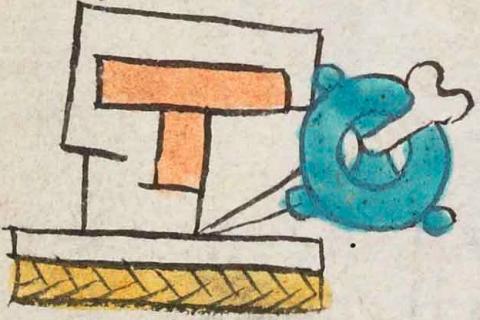Tlazoxiuhco (Mdz20v)
This compound glyph for the place name Tlazoxiuhco includes two phonetic elements, in this case the bone used for piercing, stringing, or sewing (tlazotl) and the glyph for turquoise (xihuitl). The locative suffix -co is not represented visually. Two additional elements that are visual include the building (calli) and, below that, a woven mat (petlatl), neither of which enter into the phonetics of the place name, at least as glossed. The turquoise glyph consists of concentric circles with four tiny circles at each of four points. The inner circle has two openings, almost oval shaped. It is entirely painted turquoise blue. The needle has a sharp point at the lower end, and the top looks like the joint of a bone. The house is a classic profile with the entrance on the viewer's right. It is painted white and has the t-shaped beams in a terracotta color. The mat has the classic herringbone, woven pattern. It is a narrow, horizontal rectangle, painted yellow.
Stephanie Wood
While the "tlazo" is a visual of a sewing tool, it doubles phonetically as the word for "precious." The place of the precious turquoise seems more likely than any reference to a turquoise piercing tool. The four small circles around the perimeter of the circle in the xihuitl glyph may indicate resplendence, given the way such elements can be found in other shiny objects, such as a mirror or the sun (see below, right). Carved bones were known to have been used in bloodletting, which was a religious, auto-sacrificial activity.
Stephanie Wood
tlaçoxiuhco. puo
Tlazoxiuhco, pueblo
Stephanie Wood
c. 1541, but by 1553 at the latest
Stephanie Wood
Only two clearly enter into the place name as glossed.
The "tlazo" and "xiuh" elements are merged, and the (silent) house element may serve as a semantic indicator for the "co" locative suffix. It is the reading of the petlatl that remains undetermined.
turquoise, needles, piercing, bloodletting, turquesa, agujas, perforando, auto-sacrificio, sangre, nombres de lugares, hueso, huesos

tlazo(tl), something pierced or perforated, https://nahuatl.wired-humanities.org/content/tlazotl
xihui(tl), turquoise or year, https://nahuatl.wired-humanities.org/content/xihuitl
-co (locative suffix), https://nahuatl.wired-humanities.org/content/co
Codex Mendoza, folio 20 verso, https://digital.bodleian.ox.ac.uk/objects/2fea788e-2aa2-4f08-b6d9-648c00..., image 51 of 188.
The Bodleian Libraries, University of Oxford, hold the original manuscript, the MS. Arch. Selden. A. 1. This image is published here under the UK Creative Commons, “Attribution-NonCommercial-ShareAlike 3.0 License” (CC-BY-NC-SA 3.0).






